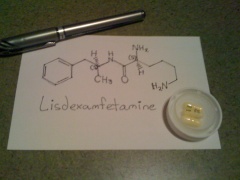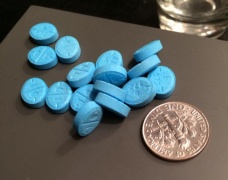Stimulants
Stimulants induce temporary improvements in either mental or physical functions or both, increasing the functioning of the central nervous system. They are also occasionally referred to collectively as 'uppers.'
Common Stimulants
Many psychedelic drugs such as LSD or 2C-X are also stimulating to varying degrees.
History
Stimulants have a long history of human use, with cocaine having been used for thousands of years in its plant form in South America, for the purposes of wakefulness and recreation; it also saw heavy use in the Western world during the 19th century when it was sold as a drug to combat fatigue, as well as being used during medical procedures as a local anaesthetic. Amphetamines were first developed and used medically for the same reasons in the early 20th century, and remain heavily prescribed to this day. Today, stimulants are also widely and legally used without prescription across the world in the form of caffeine and nicotine, along with continuing illicit use of other common stimulants.
General Effects
For more details refer to specific categories or substances.
Positive
- Euphoria
- Mental stimulation
- Improved physical performance
- Wakefulness
- Increased alertness
Neutral
- Weight loss
- Loss of appetite
Negative
- Disturbances in circadian rhythm
- Dehydration
- Tachycardia (Fast heart rate)
- Hypertension (High blood pressure)
- Bruxism
- Muscle tension
- Sleep deprivation
Further and more serious issues can arise following a binge or during withdrawals from stimulants, see the Quick Guide to Stimulant Comedowns for more information.
Addiction
The vast majority of stimulants carry a high risk of habituation and addiction when abused. Depending on the chemical and degree of abuse, withdrawal symptoms for a habituated user vary in effect, duration and intensity; see the Quick Guide to Stimulant Comedowns for more information.
Harm Reduction
The harms of stimulants come in two general classes: 1) Harms that come from the direct pharmacology of the substance and 2) Harms that come from the behaviours exhibited by stimulant users.
Route of Administration
Many stimulants can be vaporized or insufflated. This can cause damage to the nasal lining, oral mucosa and lungs. Ensuring that equipment is clean and sterile can prevent infection as well as making sure pipes are free of cracks and defects. As stimulants place extra strain on the cardiovascular system, it is advised that those who have pre-existing heart conditions or damage avoid stimulant use entirely.
Additionally, methods that cause levels of the drug to increase rapidly and decline rapidly are prone to redose compulsion. Most stimulants are well absorbed orally, and this should be the prefered ROA if possible.
Sleep
Sleep deprivation is also a common side effect of stimulant use, and prolonged sleep deprivation can lead to more serious conditions such as psychosis or sudden death. Long-acting stimulants are best dosed once in the early morning as to avoid any interference with sleep. It is important to get normal levels of sleep every night. A sleep deficit takes much longer to recover from than to create.
Food
Most stimulants strongly suppress appetite. It is important to get enough macro and micronutrients while using stimulants. While tolerant users will have fewer problems eating normal foods, newer users can find themselves unable to eat at all. Easy to eat foods should be obtained prior to stimulant use so they can be eaten as needed. Fruit and cereal grains can provide needed starch and sugar. Proteins and fats can be obtained from yogurt, nuts, or commercial trail mix.
Self Care
It can be easy to neglect the needs of your body while using stimulants. Stimulants often cause xerostomia which is exasperated by constantly drinking sugary liquids. Water is the best fluid for hydration and does not promote decay. After eating or drinking caloric liquids it is important to brush your teeth. Bruxing is a common side effect of stimulant use. Sugar-free gum or custom occlusal guards can be obtained to limit the impact of bruxing not only on your teeth but also on the muscles of the jaw and neck.
Direct Pharmacological Harm
Stimulants can be directly neurotoxic and tend to cause progressive harm over time to the cardiovascular system. Be sure to research the toxicity of any new stimulant you use, especially when using novel stimulants. Harm tends to be correlated strongly with dose and frequency of use, reduce these if at all possible.
Interactions
Stimulants cause many of their effects by regulating and enhancing the regular function of bodily systems, including the central nervous, cardiovascular, circulatory, respiratory and more. When stimulants are combined with other drugs the resulting mix of body-signals can be dangerous in a variety of ways.
Using stimulants in combination with other stimulants typically causes an increase in the extent to which one or more of the drugs' effects are felt upon the body. This can result in over-stimulation and potentially dangerous increases in blood pressure, heart-rate/rhythm, and core temperature.
The combined effects of stimulants and depressants will often result in some of the effects from one or more drug being reduced in either perceived or actual severity.
It is difficult if not impossible to determine how much the effects of one drug may be altered by another drug.
As such it is very easy to misjudge the differences in overall effect on vital functions when combining depressants with stimulants.
Furthermore, the duration of the effects produced by different drugs will vary.
This means that the effects from a stimulant may wear off sooner than the depressant's effects do, or vice-versa. For example, it is possible for speedball users to go into cardiac arrest from the sudden increase in depressant effects once the stimulant-drug wears off.
Refer to Drug combinations for more specific information.
Research Chemicals
RC stimulants often carry a very high risk of addiction, since they are often relatively inexpensive and are generally designed to be more and more potent physically and in terms of their effects. With all drugs,ROA and dose plays an important role in governing effects and risks, however stimulants are particularly relevant since many of them are short-acting and highly potent. For example, many new stimulants such as 2-DPMP/3,4-CTMP are active at extremely low doses (under 10mg's), while some such as most cathinones are active in the 100mg+ range.
See the Research Chemicals page for more information.
Images
-
Vyvanse (Lisdexamfetamine)
-
Adderall
Links
https://en.wikipedia.org/wiki/Stimulant
http://wiki.bluelight.org/index.php/Category:Amphetamines

